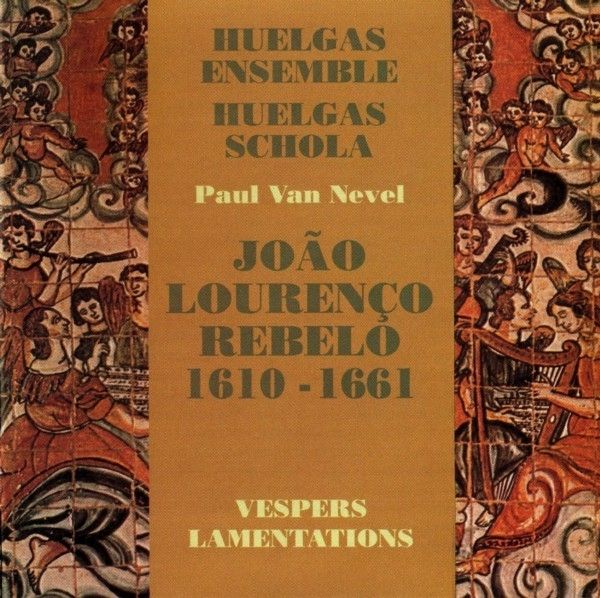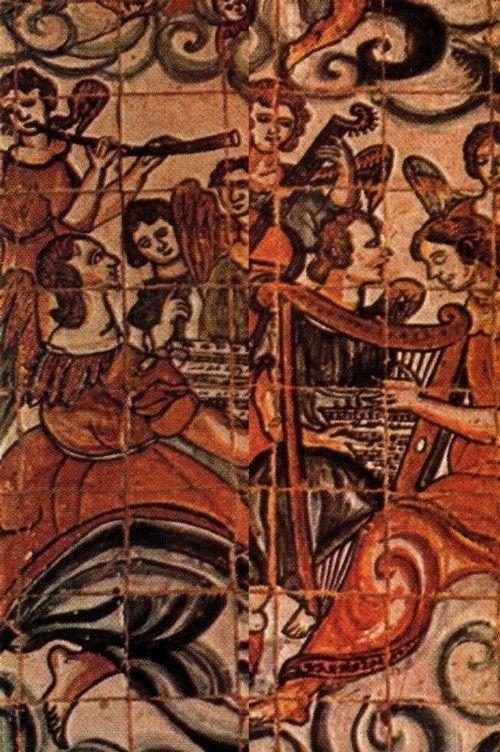
medieval.org
Les disques du Crépuscule TWI 330-2
1994
LP, 1985: Les disques du Crépuscule TWI 330
Vespers

medieval.org
Les disques du Crépuscule TWI 330-2
1994
LP, 1985: Les disques du Crépuscule TWI 330
Vespers
01 - Dixit Dominus à 16 [6:20]
02 - Laudate pueri à 7 [6:08]
03 - Credidi proper à 8 [5:27]
04 - Laudate Dominum à 10 [3:28]
05 - Lauda Jerusalem à 16 [8:24]
06 - Lamentations à 8 [13:36]
THE HUELGAS ENSEMBLE
Lorenzo Alpert, bass-curtal
Wim Becu, tenor-sackbut, bass-sackbut
Josep Benet, tenor
Willem Bremer, cornetto, alto-pommer, tenor-pommer
Kees De Bruijn, baritone
Lieven De Roo, bass
John Dudley, tenor
Nils Ferber, shawm, alto-pommer, alto-curtal
Virginie Hermant, soprano
Nancy Long, mezzo-soprano
Harry Ries, alto-sackbut, tenor-sackbut
Ingrid Smit-Duyzentkunst, altus
Marjan Van Giel, soprano
René Van Laken, tenor-pommer, tenor-curtal
Erik Van Nevel, baritone
Willy Verdievel, tenor-sackbut
Ingrid Wage, mezzo-soprano
Claude Wassmer, alto-curtal, bass-curtal
Sabine Weill, shawm, alto-curtal
THE HUELGAS SCHOLA
Anne Crabbe
Rika Joris
Anne Mertens
Nele Minten
Chris Nieuwenhuysen
Lucia Van Westerlaak
Ingrid Wage
Directed by Paul Van Nevel
Instrumentation - Paul Van Nevel
Digitally recorded in the church of Alden Biezen, Belgium
on June, tth and 8th 1984
Musical engineer - Jan Vanwelkenhuysen
© Créspuscule, 1994
Published by Usura The LOME ARME Collection is directed by Wim Mertens

JOÃO
LOURENÇO REBELO
and the Portuguese polyphony during the first half of the 17th century
At the age of 14 João Lourenço Rebelo (1610-1661) was
admitted into the Chapel Ensemble of the court of the Duke of
Bragança, Teodosio II, a maecenas and a great music lover.
Rebelo was noticed early for his talent as a composer and Teodosio
appointed him to teach his son João IV, who was to become a
serious musician-composer in his own right. During this period
João Lourenço Rebelo had the opportunity to document the
composing techniques outside Portugal, having at his disposal the
enormous music library of Teodosio II.
Initially the court ensemble for which Rebelo wrote his music consisted
of 24 vocalists and a small number of instrumentalists. However, this
group was eventually enlarged, with emphasis on the wind instruments.
Contrary to the edicts imposed by the Church not to use instruments
(which, it was believed, could be a distraction to the congregation)
the Portuguese Court Chapel used instruments, mainly winds, in
conjunction with the choir during worship. Rebelo was one of the first
Portuguese composers to write instrumental parts for the polyphonic
pieces.
Rebelo was a composer who paid little heed to the technical limitations
of the times, as proven by the structure of his compositions, often
revealing a unique and original approach; e.g.: Rebelo often used the
"Chiavette" technique, using several vocal parts which were technically
very difficult to sing. Moreover, Rebelo often ignored the protocol of
Liturgy resulting in a somewhat "liberal" interpretation of the psalms.
Working in a "Gabrielian" style, he built highly asymmetrical
combinations, playing with acoustic effects and harmonic contradictions.
The use of the chromatics was applied whimsically. In short, the
experimental approach of Rebelo must have proved a difficult task for
the court musicians of the times and certainly set his work apart from
that of his contemporaries. Nevertheless the composer began to be known
outside the court and saw his work performed by three of the most
important cathedral choirs at the time: Coimbra, Elvas and Evora.
At the Royal Court in Lisbon, Rebelo continued to experiment with his
new style, in which he was strongly supported by - the now King -
João IV. The former pupil of Rebelo even wrote a musical
treatise defending Rebelo's new style, to the point of contradicting
the tradition of the time by dedicating his work to Rebelo himself. To
appreciate the gravity of this situation, one must be aware of the
musical reality of the times in Portugal. Ruled by Spain, the Arts in
Portugal had been under the strict jurisdiction of the repressive
Jesuit order. Contemporaries of Rebelo such as the famous Filipe De
Magalhães (†1652) wrote in a purely classical style that
didn't show any contemporary influence. Rebelo offered a new sound in
this conservative environment. The innovations he introduced to the
Portuguese polyphony broke away from the classically dominated scene.
He was the first to break with the themes of classical counterpoint. He
made an almost exclusive use of the multichoral Venetian techniques and
of daring chromatic and tonal treatments.
His text-treatment was rather ambiguous; sometimes musically supporting
the text, sometimes writing musical structures totally unrelated to the
text. Rebelo was not interested in distributing his work in Europe and
took no initiative in having his works printed. However, his friend,
the king João IV, did take the initiative and in 1657 a precious
print (with no less than 16 vocal parts and a basso continuo) appeared
in Rome entitled "Joannis Laurentii Rabello Psalmi, tum vesperarum tum
complementarum. Item magnificat, Lamentationes et Miserere. Romae.
Typis mauritii et amadei balmontiarium..." The king didn't live to see
the first edition, dying in the late autumn of 1656. Ha was succeeded
by Alfonso XI. After the death of his close friend, no more testimonies
concerning Rebelo's activities remain. The musical print of 1657 is the
only proof of Rebelo's preference for the new style of composition and
indeed of his very existence as a composer. Rebelo died on November 16,
1661. His fame as an innovative composer however continues to survive.
Rebelo's compositions and their style
The most remarkable characteristic of Rebelo's style is undoubtedly his
preference for the Venetian polyphony. He extended the "Coro Spezzato"
technique of Giovanni Gabrieli and contemporaries and combined it with
the Italian "concertante" style. The polyphony created from the
different, sometimes assymmetrically constructed sound groups, always
consists of a mixture of vocal and specific instrumental components.
This practice is emphatically present in e.g. the volumes of the
vespers (Dixit Dominus and Lauda Jerusalem): four four-part groups
concert with each other, while the instrumental parts are mainly
conceived for the wind-instruments (dulcians and trumpets). The
question arises how did Rebelo become acquainted with the Italian
school? Most probably he had been able to absorb the polyphonic
techniques thanks to his access to the rich music library of
João IV. The fact that Rebelo had an intimate knowledge of
several Italian prints can be concluded from a fragment of his
introduction to the 1657 print: "...Even if my studies, which only
slowly proved to be fruitful, were admired by some,... I feared the
critique of the masters who, with their monumental issues, offered
lustre and glory to the art of music..." The use of chromatics is an
important element in the expressiveness of Rebelo's language. He uses
this stylistic device in passages where the text almost begs for
chromaticism (e.g. in the part Amaritudine of the Lamentations for
eight voices). On the other hand, in the other parts chromatics will
appear all of a sudden, without any inducement from the text. Another
indication that Rebelo wrote "his own music". This is again exemplified
by the fact that Rebelo composed apart from the contemporary praxis: he
wasn't bothered by the tessiture problems e.g., which can be extremely
big. It even occurs that within only a few bars the two octaves are
covered.
Also his approach to using texts often clashed with the liturgical
protocol. In certain psalms Rebelo broke up the regular alternation
between polyphonic and Gregorian verses. He left out verses that didn't
inspire him. Sometimes he even changed the textual structures as in the
last psalm of the vespers, the "Lauda Jerusalem".
He lets these words be repeated till five times in places where they do
not belong at all. From those observations, we infer that Rebelo writes
text-underlining pages, as well as compositions in which the text is
merely a "pretext" to write down purely musical ideas. Rebelo's
soundwork is the "renaissance of the seventeenth century", using a
"contradictio in terminis". It is music that radiates the spirit and
the magnificence of the late 16th century amidst a "strange"
environment still filled with Palestinian ideals and at a time when the
baroque style was about to bloom in the rest of Europe. In the
sound-scenery of the seventeenth century, this music can only take a
very distinctive place, with its fresh virtuosity, its charming
anachronisms and its brilliant treatment of concertant use of multiple
choirs and of arbitrary text-processing.
Paul Van Nevel
